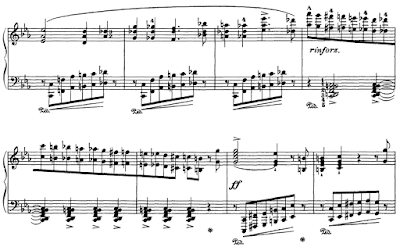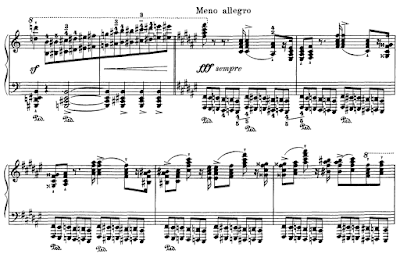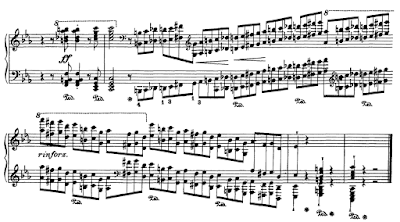Scriabin’s Sonata No.5, Op.53 for piano solo has a freneticism and vivacity that rivals his other piano sonatas, with a constant energy electrifying the whole piece. While carrying intense dissonances, the piece has almost a poetic quality in the violently changing emotions and complex motives that return throughout the piece. The whole sonata is a single movement, so strap in for a wild ride.
The piece opens at Allegro. Impetuoso. Con stravaganza. ("Fast. Impetuous. With eccentricity.") with an intensely metallic tremolo with a deep bass register tritone, flickering into the darkness with a series of rising arpeggios on the D#-A and A-E (L) and D# and G# (R) that comprise the opening tritone [with interrupting flares in the right hand].
After the violent entrance, the piano shrinks to Languido for the next section with ambiguous time (complex time signatures that are often changing, with the 5/8 feel being very unclear at times). A simply motivic ascending minor third and descending minor third followed by a briefly rising chromatic passage is introduced in this section of the piece.
Throughout the piece, several pianistic textures are explored with increasingly atonal chromatic motion, constantly shifting tonal centers, and suggestions of the texture from the preceding section.
Wild dynamic changes outline the piece. A transition from the fluctuating time signatures leads to a dance-like melody in 6/8. With its tremendous skips in triads for the right hand paired with quadruplets in the left, the overlapping rhythms creates a careful balance between a frenetic rush and a lighthearted dance at Presto con allegrezza.
The piece quickly gives way to a thunderous alternation of triads.
Scriabin now breaks out into the recognizable start of the exposition of a severely distorted sonata-allegro form. The style and dynamic marking of f imperioso perfectly describes the section.
It recedes into an ever-more chromatic section, with at once contrary motion chromatic lines with more dissonant and ghostly chords, welcoming more tritones and augmented chords.
A short interruption at Allegro fantastico initiates the development of the sonata-allegro form, giving way to more darkly metallic Presto tumultuoso esaltato ("Tumultuously fast, exalted").
The return of rhythmic and motivic ideas from the previous Presto blurs the idea of whether the development is itself a recapitulation or just the development. Below, you can see the entire development, and all of the places where motifs from both the introduction and the exposition are repeated.
This blurring of the structural lines of the sonata-allegro form is further influenced by the return of the introduction in the middle of the development, up a major second. You could consider this to be the start of a recapitulation that lasts the entire rest of the movement, or perhaps this is a partial recapitulation ... or perhaps this is just the development.
Here, you can see the introduction and the start of the "development" side-by-side, with motivic ideas highlighted. The succeeding Languido has nearly the same form as the first time around.
A chromatically widening interval from a G#5 down a minor third to down a perfect fourth (orange) eventually gives way to a game of tag between the "pink" and "red" motifs, and later 6/8 and 5/8 ideas over fragments of introduction melodies, interspersed with the imperioso figure. The development introduces very few new ideas, and just transplants and recombines ("develops") the original ideas in new ways.
Following a frantic mini-climax, Scriabin copies material from the first Presto con allegrezza, sprinkling shards of sparkling introduction melody into it: the opening Languido theme appears in a heavily arpeggiated form at Presto giocoso.
The interlude after the Presto returns to the contrary moving chromatic figures once again...
...and includes a foreshadowing of the closing Presto in its short bursts of Allegro fantastico.
A drawn-out accelerando creates the impression of a recapitulation, but this is just the continued development (which recapitulates ideas from the exposition ... is this sonata-allegro form confusing enough yet?).
Notice the many motifs from the exposition that Scriabin repeats and develops in this section (after appearing just once in the exposition; find the red box in the maroon region above):
The calm chromatic figure with the wild dissonance makes a bombastic appearance, climbing higher and higher on the keyboard in each of its four appearances (two shown below). This ascent closes out the development.
Scriabin abruptly ends the development and blasts off at Prestissimo, marking the start of the true recapitulation.
Below are the exposition (top) and recapitulation (bottom). You can see that Scriabin cuts the recapitulation short, perhaps to balance the return of several motifs in the development:
After reestablishing several of the themes introduced in the exposition, Scriabin breaks out into the recognizable part of the exposition: the wide melodies at f imperioso:
The recapitulation settles back into the chromatic soup, the last shred of peace, once more before exploding into the coda.
After traversing a wildly distorted sonata-allegro form, we finally arrive at the coda. The style markings vertiginoso con furia (“dizzy with fury”) and con luminosità (“with brightness”) are apt descriptors of this coda with sparkling figures in the highest register of the piano and a dialogue between the stormy bass and the shimmering treble voices.
The motivic idea from the very first Presto con allegrezza appears in bits and pieces, frequently augmented (stretched rhythms), and another imperioso figure (red boxes) also appears in augmentation.
The Languido theme with the minor third returns at estatico near C6-G6 in the key of E-flat major with a constantly hammered E♭1 and E♭2 in the left hand, a call to the initial D#s that were used in the opening tremolo.
A grinding ritardando bursts into a final devastating Presto that uses the jumping triads for the final time.
The frenzy of rising arpeggios on the opening D#-A and A-E (L.H.) and D# and G (R.H.) that so searingly announced the opening bookends it, bringing the sonata’s tragic freneticism to a halt.
In review, here is the entire piece minus the coda — there are so many distinct ideas, and yet almost every segment of the sonata-allegro form (introduction, exposition, development, recapitulation, and coda) uses nearly every one of those ideas. Pretty incredible writing.
If you go back and listen to the entire piece with a high-level view of the musical structure, you can really appreciate the scale at which Scriabin was writing works even just for solo piano.
Thanks for reading and listening along! Share if you enjoyed this post, and leave your comments below!
All excerpts taken from the 1971 Edition Peters (Leipzig) score via IMSLP.org.
The piece opens at Allegro. Impetuoso. Con stravaganza. ("Fast. Impetuous. With eccentricity.") with an intensely metallic tremolo with a deep bass register tritone, flickering into the darkness with a series of rising arpeggios on the D#-A and A-E (L) and D# and G# (R) that comprise the opening tritone [with interrupting flares in the right hand].
After the violent entrance, the piano shrinks to Languido for the next section with ambiguous time (complex time signatures that are often changing, with the 5/8 feel being very unclear at times). A simply motivic ascending minor third and descending minor third followed by a briefly rising chromatic passage is introduced in this section of the piece.
Throughout the piece, several pianistic textures are explored with increasingly atonal chromatic motion, constantly shifting tonal centers, and suggestions of the texture from the preceding section.
Wild dynamic changes outline the piece. A transition from the fluctuating time signatures leads to a dance-like melody in 6/8. With its tremendous skips in triads for the right hand paired with quadruplets in the left, the overlapping rhythms creates a careful balance between a frenetic rush and a lighthearted dance at Presto con allegrezza.
The piece quickly gives way to a thunderous alternation of triads.
Scriabin now breaks out into the recognizable start of the exposition of a severely distorted sonata-allegro form. The style and dynamic marking of f imperioso perfectly describes the section.
A short interruption at Allegro fantastico initiates the development of the sonata-allegro form, giving way to more darkly metallic Presto tumultuoso esaltato ("Tumultuously fast, exalted").
The return of rhythmic and motivic ideas from the previous Presto blurs the idea of whether the development is itself a recapitulation or just the development. Below, you can see the entire development, and all of the places where motifs from both the introduction and the exposition are repeated.
This blurring of the structural lines of the sonata-allegro form is further influenced by the return of the introduction in the middle of the development, up a major second. You could consider this to be the start of a recapitulation that lasts the entire rest of the movement, or perhaps this is a partial recapitulation ... or perhaps this is just the development.
Here, you can see the introduction and the start of the "development" side-by-side, with motivic ideas highlighted. The succeeding Languido has nearly the same form as the first time around.
A chromatically widening interval from a G#5 down a minor third to down a perfect fourth (orange) eventually gives way to a game of tag between the "pink" and "red" motifs, and later 6/8 and 5/8 ideas over fragments of introduction melodies, interspersed with the imperioso figure. The development introduces very few new ideas, and just transplants and recombines ("develops") the original ideas in new ways.
Following a frantic mini-climax, Scriabin copies material from the first Presto con allegrezza, sprinkling shards of sparkling introduction melody into it: the opening Languido theme appears in a heavily arpeggiated form at Presto giocoso.
The interlude after the Presto returns to the contrary moving chromatic figures once again...
...and includes a foreshadowing of the closing Presto in its short bursts of Allegro fantastico.
A drawn-out accelerando creates the impression of a recapitulation, but this is just the continued development (which recapitulates ideas from the exposition ... is this sonata-allegro form confusing enough yet?).
Notice the many motifs from the exposition that Scriabin repeats and develops in this section (after appearing just once in the exposition; find the red box in the maroon region above):
The calm chromatic figure with the wild dissonance makes a bombastic appearance, climbing higher and higher on the keyboard in each of its four appearances (two shown below). This ascent closes out the development.
Scriabin abruptly ends the development and blasts off at Prestissimo, marking the start of the true recapitulation.
Below are the exposition (top) and recapitulation (bottom). You can see that Scriabin cuts the recapitulation short, perhaps to balance the return of several motifs in the development:
After reestablishing several of the themes introduced in the exposition, Scriabin breaks out into the recognizable part of the exposition: the wide melodies at f imperioso:
The recapitulation settles back into the chromatic soup, the last shred of peace, once more before exploding into the coda.
After traversing a wildly distorted sonata-allegro form, we finally arrive at the coda. The style markings vertiginoso con furia (“dizzy with fury”) and con luminosità (“with brightness”) are apt descriptors of this coda with sparkling figures in the highest register of the piano and a dialogue between the stormy bass and the shimmering treble voices.
The motivic idea from the very first Presto con allegrezza appears in bits and pieces, frequently augmented (stretched rhythms), and another imperioso figure (red boxes) also appears in augmentation.
The Languido theme with the minor third returns at estatico near C6-G6 in the key of E-flat major with a constantly hammered E♭1 and E♭2 in the left hand, a call to the initial D#s that were used in the opening tremolo.
A grinding ritardando bursts into a final devastating Presto that uses the jumping triads for the final time.
The frenzy of rising arpeggios on the opening D#-A and A-E (L.H.) and D# and G (R.H.) that so searingly announced the opening bookends it, bringing the sonata’s tragic freneticism to a halt.
In review, here is the entire piece minus the coda — there are so many distinct ideas, and yet almost every segment of the sonata-allegro form (introduction, exposition, development, recapitulation, and coda) uses nearly every one of those ideas. Pretty incredible writing.
If you go back and listen to the entire piece with a high-level view of the musical structure, you can really appreciate the scale at which Scriabin was writing works even just for solo piano.
Thanks for reading and listening along! Share if you enjoyed this post, and leave your comments below!
All excerpts taken from the 1971 Edition Peters (Leipzig) score via IMSLP.org.

































































